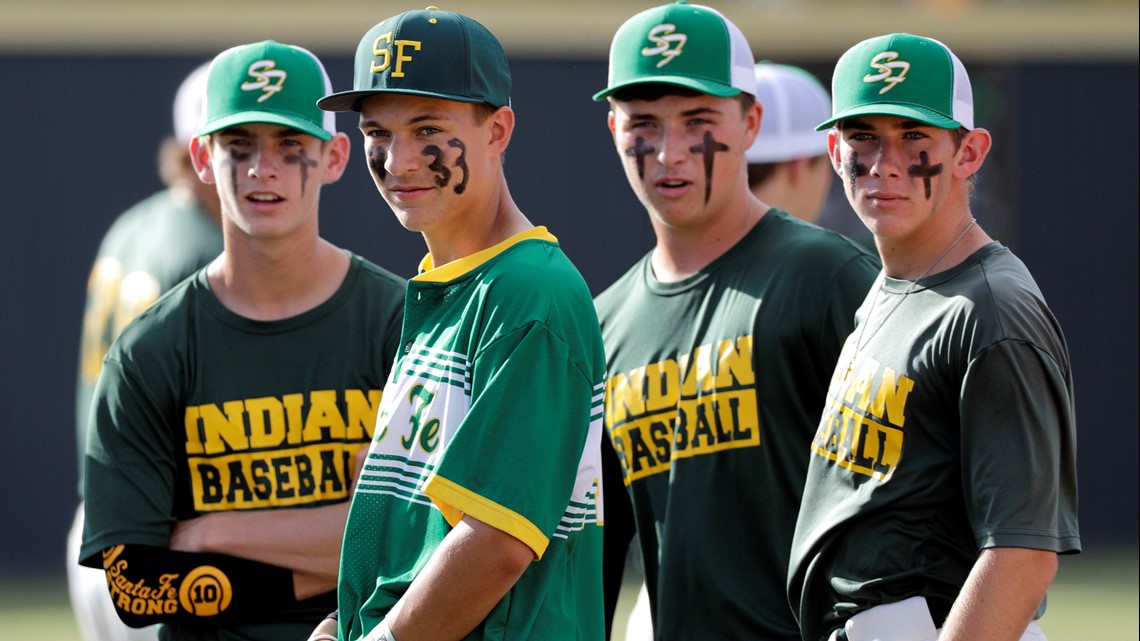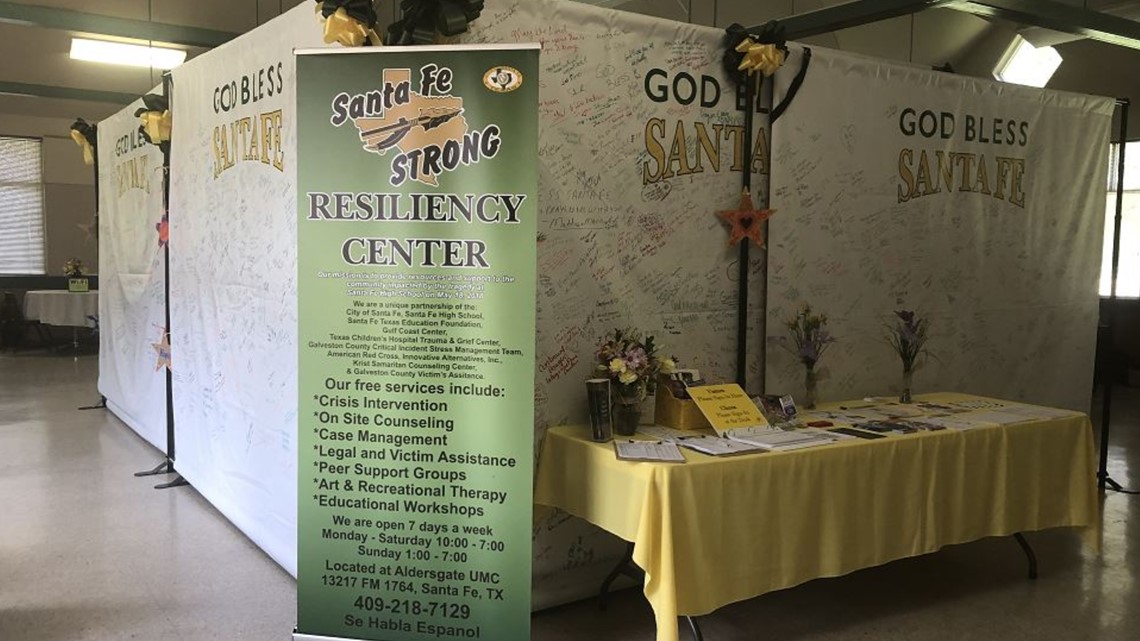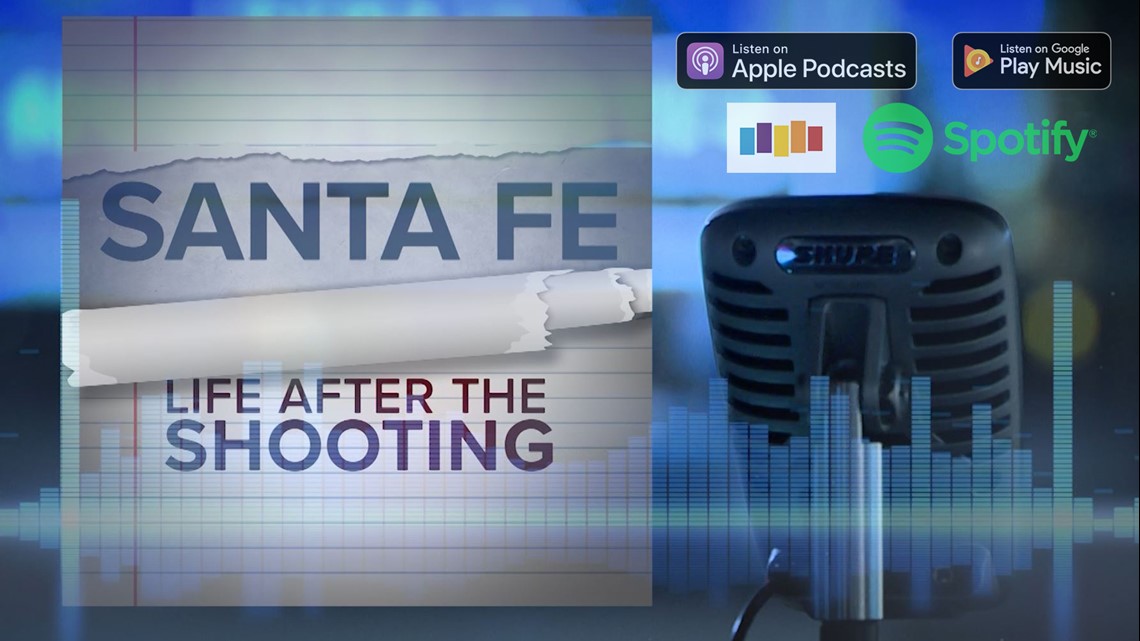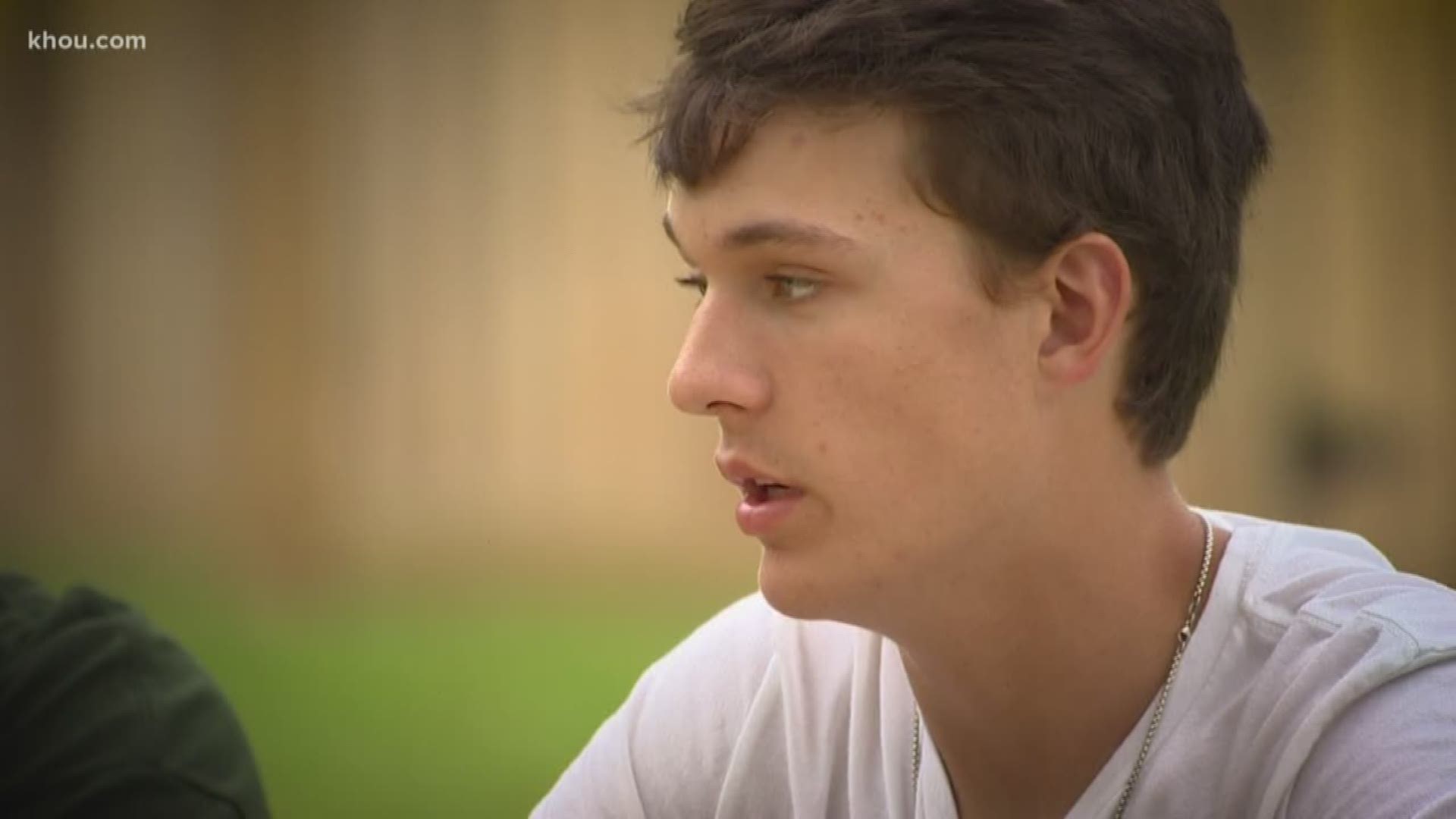On a muggy Thursday night, Trenton Beazley took the baseball field with his 16 teammates. It was a big night for the Santa Fe Indian baseball team. The Indians were coming off a regular season in which they won the district title, and now it was time for playoffs.
It’s what the team had been waiting for all season: make the playoffs, string a few wins together and go all the way to state—the ultimate championship in high school sports.
Trenton had on a white jersey with Indians written in gold on the front and a No. 14 on the back. He’s played baseball since he was 5 years old, rising from the ranks of Little League to starting catcher for the Santa Fe varsity baseball team.
But since the shooting at Santa Fe High School a year ago, baseball has meant even more to him. Trenton, then a sophomore, was in an art room closet on May 18, 2018 as the shooter stood outside, firing in the closet.
Ten people were killed and 13 others injured. Trenton saw two students die. He helped save a girl who was badly bleeding. A bullet ricocheted and grazed the side of his chest. He still has scars to this day.


“It’s hard going through something like this. It’s tough. I have my bad days, my bad weeks,” said Trenton, now 16.
So often, Trenton’s thoughts are filled with what happened that day and what he saw. But when he’s on the baseball field, his mind clears and for a time—however brief—he can forget.
“When I go out there on the field—if I’m having a bad day at school—when I go out there on the field, everything clears,” he said. “I have fun, I let up, have fun, let loose.”
It’s been a year since the shooting. Heartbroken families are still coping and learning to live with a new normal. Students still struggle with returning to the school where so much destruction happened.
The art hallway where the shooting occurred is now blocked off. But those barriers are a daily reminder of the lives lost, the students no longer there, the shooting that changed so much of their young lives.
Wade Jordan is a sophomore at Santa Fe and said school doesn’t feel the same.
“It doesn’t feel like high school anymore; it doesn’t feel like it did last year,” he said. “It’s kind of rough to go back into school every day and try to act like everything is fine and get through classes.”
Wade wasn’t at the school the day of the shooting, but he struggles with survivor’s guilt. Had he been at the school, he said he would have been in the classroom across the hall from the art class. He can’t help but wonder if there’s something he could have done to stop the shooter, to prevent his classmates from dying?
Instead of going to school that day, Wade planned to do what high school students sometimes do: rebel and skip class. His mom was at work and he planned to spend some time with his girlfriend.
But on her way over, Wade got a text about a shooting at the school. He watched people’s Snapchat videos of students running from the campus. He tried texting and calling his friends—only for those texts and calls to go unanswered.
“I was very, very worried about my friends because they were in the class right next to it,” Wade said. “There were some people I couldn’t even call because they didn’t have their phones because they had to leave it in their classes.”
Wade called his mom, Mandy, who rushed home from work. They spent the rest of the day watching the news unfold, feeling helpless.
As word spread that the shooter entered the art classroom, Wade felt sick. If he was at school that day, would he have died?
He couldn’t shake the thought. As the weeks passed, Mandy watched as her son cried often. He stopped eating. Couldn’t sleep. Stopped hanging out with friends. He hardly ever left the couch.
“I stayed away from everybody,” Wade said. “It was bad. It was a horrible place for me to be.”
He was consumed by the what ifs of that day. Had he gone to school, he said, he likely would have walked in about the same time as the shooter. What if he could have ran and tackled the shooter? What if he had been one of the students shot? What if his death could have prevented more deaths?
Mandy realized her needed more help than she could give.
“I was like, ‘This is more than I know what to do. I’m your mom, I can love you, I can hug you, I’m not a mental health expert. I can’t help you the way I think you need it,’” she said.


She took him to the Santa Fe Resiliency Center, a spot in town where anyone affected by the shooting can get help. Wade was assessed and it was determined he needed specialized treatment to address his survivor’s guilt and bring him out of his depression.
Wade, who recently turned 16, still continues that treatment through a program with Texas Children’s Hospital that focuses on kids who have gone through intense trauma. He said that help has helped in his recovery.
He still has his struggles today. Some days he said he can’t get out of bed, some nights he doesn’t fall asleep until it’s time to get up. He’s missed his share of school and has fallen behind in some classes. He’s altered his schedule to arrive later. But he said he’s in a better place than months ago.
“I really pushed people away at first and it was the worst thing I ever did, when in reality I should have opened up and got help like I did,” Wade said. “I don’t know when I stopped feeling so down. I’ve been a lot better now and it was random for me, but dealing with it every morning and going into that school realizing that I could have done something, that I could have been there or I could have been on that list, it’s just kind of worrying.
“It’s not good to think like that because all that does is put you further and further down into a hole that you won’t be able to get out of, but with help you can.”
Mandy is trying to adjust to their new normal, too.
She and her husband are now separated. She’s had to find a new job that offers a more flexible schedule so she can get her son to school or to his appointments.
“It’s like another wave hits you almost every day,” she said. “It’s like every day it’s just another challenge, another wall you hit, and you’re trying to find another way around it. It’s emotionally exhausting.”
But she tries to keep a positive outlook. Every day she’ll ask Wade, “What made today great?” They celebrate the little victories, like getting out of bed when they may not feel like it or making it through a day without a panic attack.
“I didn’t realize how traumatic this is for parents, as well, to watch your child suffer and not be able to help them as much as you want,” she said.
Through it all, there’s one important thing she learned.
“I’m realizing it’s OK to not be OK. It’s OK to have a bad day. It’s OK to tell people I just can’t today,” Mandy said.
RELATED: Santa Fe therapists remind students, parents of free counseling after Parkland suicides reported
Julie Kaplow is a doctor with Texas Children’s Hospital who leads the hospital’s trauma and grief center. She’s been in Santa Fe since the day after the shooting and watched how the tragedy affected the tight-knit community.
“Having something like that happen in your community is obviously very distressing,” Kaplow said. “I think also in that initial phase there’s a lot of shock and disbelief.”
She noted that initially after the shooting a lot of people were hesitant about seeking help, but as time has passed, more families and students are coming into the Resiliency Center.
Now as the one-year mark since the shooting approaches, Kaplow worries for people who aren’t seeking help and the emotions that may arise. Kaplow said there are warnings parents and families should lookout for: refusal to go to school, not doing homework, distance from family and friends or doing drugs.
“We’re really trying to make sure that kids have enough support around the one-year mark and are not socially isolated and feel like they have the support they need,” she said.
In the early months after the shooting, Trenton Beazley thought he could get through on his own. He didn’t think he needed help, thought he could process it all himself and be fine. But his mom, Shirley, had seen how he changed. He’d lose his temper over the smallest things. The sound of a twig snapping or a book falling to the floor would send his mind back to that art room closet. Some nights, he’d wake up in the middle of the night screaming and crying.
“And that’s when I realized I needed to get help,” Trenton said. “I was a big pride person. Like, ‘Oh no, I’m going to get over this myself. I can do this, I can do this, I’m strong.’ But if you’re in that situation, you have to talk, you have to let it out, because it’s going to catch up to you eventually.”
Shirley said her son is a different person since the shooting.
“As a parent, it’s real hard to see your son go through something like this. I see his struggles and it’s hard because sometimes you’re not the one who he really wants at that moment,” she said.
Trenton leaned heavily on baseball and one of his coaches. They’d spend hours on the phone at night reading scriptures from the Bible and talking about everything he’s gone through.
Trenton is still seeing a psychologist, who’s helped him manage his feeling sand taught him to control his emotions when it feels like they’ll get the better of him. But he worries for the students who aren’t seeking help.
“A lot of kids aren’t seeking help. That’s the one thing I tell them and I tell others, ‘Even if you weren’t affected or in that room and it’s bothering you, you need to talk,’” he said. “It’s just something that’s going to catch up with you. And it caught up to me.”
Part of his healing came during a baseball trip to Florida over the summer, where he found the most unlikely of friends.
At the end of their trip, Trenton asked how far Parkland was. Three months before Santa Fe, a gunman walked into Marjory Stoneman Douglas High School and killed 17 people on Valentine’s Day.
Parkland was close enough that the family decided to stop. Trenton bought a baseball and signed it. He included his Instagram handle. He hoped to meet the baseball coach, but the coach wasn’t there, so Trenton left the baseball on his desk. Days later, the coach called and they developed a friendship off a love for baseball and similar tragedy.
The two still keep in touch. They’ll often text each other asking how their seasons are going, how they’re coping through it all.
Trenton sent the coach a box filled with Santa Fe shirts and bracelets. The coach responded by sending Trenton a red shirt that red Stoneman Douglas Eagles Baseball.
Trenton wore it on Feb. 14, the one-year mark since the shooting at Stoneman Douglas.


Podcast: 'Santa Fe: Life After the Shooting'
Reporters Grace White and Matt Keyser returned to Santa Fe a year later. What they found were heartbroken families who are still frustrated by the lack of transparency into the shooting investigation and at politicians, who some say, aren’t following through on making schools safer.
In the six-part podcast Santa Fe: Life After the Shooting, White and Keyser share these families’ stories of heartache and how those 30 minutes on May 18, 2018 have changed their lives forever.
Subscribe and listen to Santa Fe: Life After the Shooting on Apple Podcasts, Google Play, Spotify, Stitcher or wherever you get your podcasts.
Episode 1: The Day Everything Changed
A student gunman entered Santa Fe High School on May 18, 2018. He killed 10 people and wounded 13 others, casting this small Texas town into the national spotlight for all the wrong reasons.
RELATED: 'He died fighting': Family remembers son who fought to save others during Santa Fe shooting
Episode 2: The First Two
Officers John Barnes and Gary Forward were the first two officers to confront the shooter. John nearly died trying to protect hundreds of students.
Episode 3: Grammy
So little do we hear about the long-lasting effects on the victims’ families after a school shooting. This is the window into one family’s grief who is still learning to live without the woman they knew as Grammy.
Episode 4: Survivor's Guilt
For some students who have had to return to Santa Fe High School, going back hasn’t been easy. Walking through the doors of the school serves as a constant reminder of the lives lost, their friends and classmates no longer there.
Episode 5: The Long Road Ahead
Unfortunately, there are people out there who know what these Santa Fe families are going through. The principal of Columbine, two moms from Sandy Hook and the father who lost his daughter in a school shooting in Colorado share their experiences of how they continue to remember their loved ones.
Episode 6: Frustration Fuels Change
For some of these Santa Fe families, they’re frustrated and angry. They want more transparency into the shooting investigation, more accountability from politicians. And they’ve had to fight in hopes of keeping the shooter in prison for the rest of his life.

